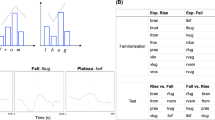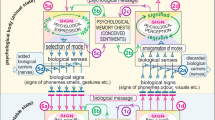Abstract
This paper presents a model of the origins of syllable systems that brings plausibility to the theory which claims that language learning, and in particular phonological acquisition, needs not innate linguistically specific information, as believed by many researchers of the Chomskyan school, but is rather made possible by the interaction between general motor, perceptual, cognitive and social constraints through a self-organizing process. The strategy is to replace the question of acquisition in a larger and evolutionary (cultural) framework: the model addresses the question of the origins of syllable systems (syllables are the major phonological units in speech). It is based on the artificial life methodology of building a society of agents, endowed with motor, perceptual and cognitive apparati that are generic and realistic. We show that agents effectively build sound systems and how these sound systems relate to existing human sound systems. Results concerning the learnability of the produced sound systems by fresh/baby agents are detailed: the critical period effect and the artificial language effect can effectively be predicted by our model. The ability of children to learn sound systems is explained by the evolutionary history of these sound systems, which were precisely shaped so as to fit the ecological niche formed by the brains and bodies of these children, and not the other way around (as advocated by Chomskyan approaches to language).
Access this chapter
Tax calculation will be finalised at checkout
Purchases are for personal use only
Preview
Unable to display preview. Download preview PDF.
Similar content being viewed by others
References
Archangeli D., Langendoen T. Optimality theory, an overview, Blackwell Pulishers (1997).
Arkin, R. Behavior-based Robotics, MIT Press (1999).
Bizzi E., Mussa-Ivaldi F., Giszter S.Computations underlying the execution of movement: a biological perspective, Science, vol. 253, pp. 287–291 (1991).
de Boer, B. Investigating the Emergence of Speech Sounds. In: Dean, T. (ed.) Proceedings of IJCAI 99. Morgan Kauffman, San Francisco. pp. 364–369 (1999).
Chomsky, N. and M. Halle (1968) The Sound Pattern of English. Harper Row, New york.
P. R. Cook, “Synthesis of the Singing Voice Using a Physically Parameterized Model of the Human Vocal Tract,” Proc. of the International Computer Music Conference, pp. 69–72, Columbus, OH, 1989.
Christiansen, M., Using artificial language learning to study language evolution: Exploring the emergence of word order universals, in Language Evolution, Dessalles, Wray, Knight (eds.), Transitions to language, Oxford, Oxford University Press (2000).
Deacon T., The symbolic species, The Penguin Press (1997).
Flege J., Speech learning in a second language, In Ferguson, Menn, Stoel-Gammon (eds.) Phonological Development: Models, Research, Implications, York Press, Timonnium, MD, pp. 565–604 (1992).
Gold, E. Language identification in the limit. Information and Control 10, 447–474 (1967).
Hurford, J., Studdert-Kennedy M., Knight C., Approaches to the evolution of language, Cambridge, Cambridge University Press (1998).
Kirby, S., Syntax without natural selection: how compositionnality emerges from vocabulary in a population of learners, in Hurford, J., Studdert-Kennedy M., Knight C. (eds.), Approaches to the evolution of language, Cambridge, Cambridge University Press (1998).
Lenneberg, E. Biological foundations of language, New-York: Wiley (1967).
Lindblom, B., Phonological Units as Adaptive Emergents of Lexical Development, in Ferguson, Menn, Stoel-Gammon (eds.) Phonological Development: Models, Research, Implications, York Press, Timonnium, MD, pp. 565–604, (1992).
Long M. Maturational Constraints on Language Development, Studies in Second Language Acquisition 12, 251–285 (1990).
Lyon, R., All pole models of auditory filtering, in Lewis et al. (eds.) Diversity in auditory mechanics, World Scientific Publishing, Singapore (1997).
Massaro, D., Perceiving talking faces, MIT Press (1998).
MacNeilage, P.F., The Frame/Content theory of evolution of speech production. Behavioral and Brain Sciences, 21, 499–548 (1998).
Pinker, S., Bloom P., Natural Language and Natural Selection, The Brain and Behavioral Sciences, 13, pp. 707–784 (1990).
Piattelli-Palmarini, M., Evolution, selection and cognition: from “learning” to parameter setting in biology and in the study of language, Cognition, 31, 1–44 (1989).
Redford, M.A., C. Chen, and R. Miikkulainen Modeling the Emergence of Syllable Systems. In: Proceedings of the Twentieth Annual Conference of the Cognitive Science Society. Erlabum Ass. Hillsdale (1998).
Sakoe H., Dynamic programming optimization for spoken word recognition, IEEE Transaction Acoustic., Speech, Signal Processing, vol. 26, pp. 263–266 (1982).
Segui, J., Dupoux E., Mehler J. (1995) The role of the syllable in speech segmentation, phoneme identification, and lexical access, in Altman, (ed.), Cognitive Models of Speech Processing, Psycholinguistics and Computational Perspectives, MIT Press.
Steels, L., Synthesizing the origins of language and meaning using co-evolution, self-organization and level formation, in Hurford, Studdert-Kennedy, Knight (eds.), Cambridge University Press, pp. 384–404 (1998).
Oudeyer P-Y., The origins of syllable systems: an operational model, to appear in the Proceedings of The International Conference on Cognitive Science, COGSCI’2001, Edinburgh, Scotland, (2001).
Oudeyer P-Y, Coupled Neural Maps for the Origins of Vowel Systems, to appear in the proceedings of the International Conference on Artificial Neural Networks, ICANN’2001, Vienna, Austria, Springer Verlag (2001).
Steels L., Oudeyer P-y., The cultural evolution of syntactic constraints in phonology, in Bedau, McCaskill, Packard and Rasmussen (eds.), Proceedings of the 7th International Conference on Artificial Life, pp. 382–391, MIT Press (2000).
Author information
Authors and Affiliations
Editor information
Editors and Affiliations
Rights and permissions
Copyright information
© 2002 Springer-VerlagBerlin Heidelberg
About this paper
Cite this paper
Oudeyer, PY. (2002). Origins and Learnability of Syllable Systems: A Cultural Evolutionary Model. In: Collet, P., Fonlupt, C., Hao, JK., Lutton, E., Schoenauer, M. (eds) Artificial Evolution. EA 2001. Lecture Notes in Computer Science, vol 2310. Springer, Berlin, Heidelberg. https://doi.org/10.1007/3-540-46033-0_12
Download citation
DOI: https://doi.org/10.1007/3-540-46033-0_12
Published:
Publisher Name: Springer, Berlin, Heidelberg
Print ISBN: 978-3-540-43544-0
Online ISBN: 978-3-540-46033-6
eBook Packages: Springer Book Archive




